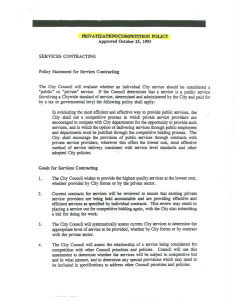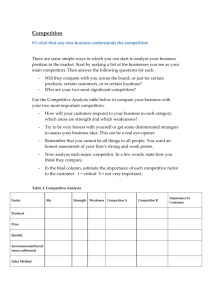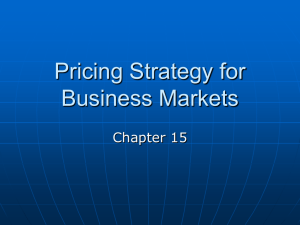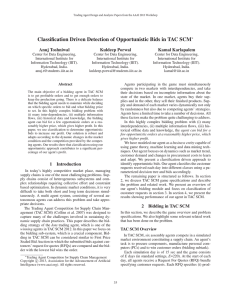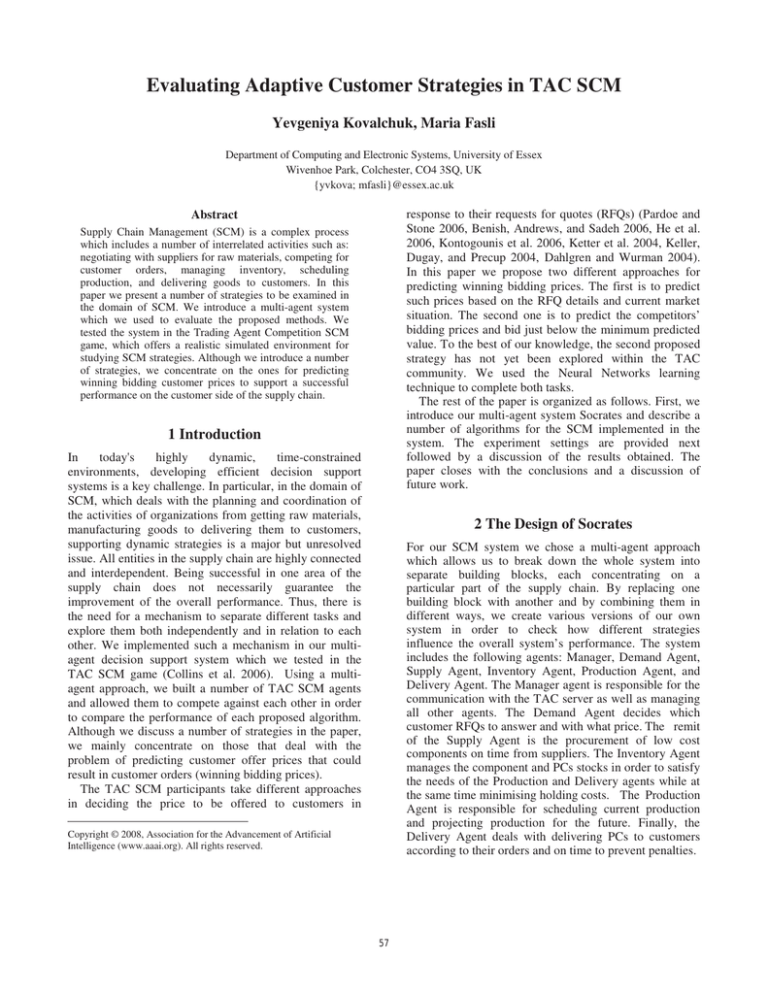
Evaluating Adaptive Customer Strategies in TAC SCM
Yevgeniya Kovalchuk, Maria Fasli
Department of Computing and Electronic Systems, University of Essex
Wivenhoe Park, Colchester, CO4 3SQ, UK
{yvkova; mfasli}@essex.ac.uk
response to their requests for quotes (RFQs) (Pardoe and
Stone 2006, Benish, Andrews, and Sadeh 2006, He et al.
2006, Kontogounis et al. 2006, Ketter et al. 2004, Keller,
Dugay, and Precup 2004, Dahlgren and Wurman 2004).
In this paper we propose two different approaches for
predicting winning bidding prices. The first is to predict
such prices based on the RFQ details and current market
situation. The second one is to predict the competitors’
bidding prices and bid just below the minimum predicted
value. To the best of our knowledge, the second proposed
strategy has not yet been explored within the TAC
community. We used the Neural Networks learning
technique to complete both tasks.
The rest of the paper is organized as follows. First, we
introduce our multi-agent system Socrates and describe a
number of algorithms for the SCM implemented in the
system. The experiment settings are provided next
followed by a discussion of the results obtained. The
paper closes with the conclusions and a discussion of
future work.
Abstract
Supply Chain Management (SCM) is a complex process
which includes a number of interrelated activities such as:
negotiating with suppliers for raw materials, competing for
customer orders, managing inventory, scheduling
production, and delivering goods to customers. In this
paper we present a number of strategies to be examined in
the domain of SCM. We introduce a multi-agent system
which we used to evaluate the proposed methods. We
tested the system in the Trading Agent Competition SCM
game, which offers a realistic simulated environment for
studying SCM strategies. Although we introduce a number
of strategies, we concentrate on the ones for predicting
winning bidding customer prices to support a successful
performance on the customer side of the supply chain.
1 Introduction
In
today's
highly
dynamic,
time-constrained
environments, developing efficient decision support
systems is a key challenge. In particular, in the domain of
SCM, which deals with the planning and coordination of
the activities of organizations from getting raw materials,
manufacturing goods to delivering them to customers,
supporting dynamic strategies is a major but unresolved
issue. All entities in the supply chain are highly connected
and interdependent. Being successful in one area of the
supply chain does not necessarily guarantee the
improvement of the overall performance. Thus, there is
the need for a mechanism to separate different tasks and
explore them both independently and in relation to each
other. We implemented such a mechanism in our multiagent decision support system which we tested in the
TAC SCM game (Collins et al. 2006). Using a multiagent approach, we built a number of TAC SCM agents
and allowed them to compete against each other in order
to compare the performance of each proposed algorithm.
Although we discuss a number of strategies in the paper,
we mainly concentrate on those that deal with the
problem of predicting customer offer prices that could
result in customer orders (winning bidding prices).
The TAC SCM participants take different approaches
in deciding the price to be offered to customers in
2 The Design of Socrates
For our SCM system we chose a multi-agent approach
which allows us to break down the whole system into
separate building blocks, each concentrating on a
particular part of the supply chain. By replacing one
building block with another and by combining them in
different ways, we create various versions of our own
system in order to check how different strategies
influence the overall system’s performance. The system
includes the following agents: Manager, Demand Agent,
Supply Agent, Inventory Agent, Production Agent, and
Delivery Agent. The Manager agent is responsible for the
communication with the TAC server as well as managing
all other agents. The Demand Agent decides which
customer RFQs to answer and with what price. The remit
of the Supply Agent is the procurement of low cost
components on time from suppliers. The Inventory Agent
manages the component and PCs stocks in order to satisfy
the needs of the Production and Delivery agents while at
the same time minimising holding costs. The Production
Agent is responsible for scheduling current production
and projecting production for the future. Finally, the
Delivery Agent deals with delivering PCs to customers
according to their orders and on time to prevent penalties.
Copyright © 2008, Association for the Advancement of Artificial
Intelligence (www.aaai.org). All rights reserved.
57
Model name
Short
NN
Full
NN
Number of Units
Input Layer
Hidden Layer
fixed
5
3
fixed
13
7
Full dynamic
NN
13
7
Attributes
Price range
current date, penalty per unit, reserve price, latest reported lowest
order price, boolean indicator of whether an offer became an order
current date, quantity, due lead time, penalty per unit, reserve price,
lowest order price reported for the last 3 days, highest order price
reported for the last 3 days, order level=[order number/RFQ
number], boolean indicator of whether an offer became an order
current date, quantity, due lead time, penalty per unit, reserve price,
lowest order price reported for the last 3 days, highest order price
reported for the last 3 days, order level=[order number/RFQ
number], boolean indicator of whether an offer became an order
Fixed
Fixed
Varied
Table 1. Models for predicting own winning bidding prices.
For our second strategy, we built two kinds of NNs for
every competitor, each predicting the competitor’s offer
price for the given RFQ. For the first type of NNs
(Identical NN Competitor Bid Price Predictors), we used
the same set of inputs for each competitor which includes
13 attributes, namely: PC type, current date, lead time,
quantity, reserve price, penalty, the lowest and the highest
market price reported during the last 3 days, and current
demand level. For the second type of NNs (Individual NN
Competitor Bid Price Predictors), we used a separate set
of inputs, depending on the parameters that each
competitor considers while deciding on its bidding prices.
To test the latter type of NNs, we set up all the
competitors so that the information on the parameters they
use for setting their offer prices is known. However, we
make no assumptions on how these parameters are used
by competitors; the predictors have to evolve the models
of the competitors’ behavior.
3 Predictive Strategies for Setting Customer
Offer Prices
Although we implemented a number of strategies in the
scope of each agent, we mainly concentrate on the ones
for the Demand Agent. In particular, we propose two
strategies for determining bidding prices which may result
in customer orders (winning bidding prices) – in the TAC
SCM game, customers award an order to the
manufacturer which offers the lowest price among all
competitors. The first strategy is to predict the probability
of the winning price for each RFQ to be within a
particular price range. We then set our offer price to the
average of the price interval with the highest predicted
probability. The second strategy is to predict the
competitors’ bidding prices and bid just below the
minimum predicted value.
We applied the Neural Networks learning technique for
both strategies using the Back-propagation algorithm to
train them on the data from the log-files of previously
played games. According to the first strategy, 16
ensembles of feed-forward neural networks (NN), one for
each PC type, predict probabilities of winning a customer
order for the specified PC type depending on the offer
price set. Each ensemble is responsible for a particular
price interval and outputs the probability of the price
within this interval being accepted by a customer. We
developed and tested 3 different NN architectures, which
are summarized in Table 1. Inputs were normalized using
the corresponding minimum and maximum allowed
values for each input. For setting minimum and maximum
values of the price units, we took two different
approaches. Two of our NN models have these values
fixed and set to the minimum and maximum values
observed in the games. The third NN model sets these
values dynamically for each RFQ separately. More
specifically, the minimum value is determined as the
discounted latest lowest order price stated in the price
report for the respective PC type: [LowestOrderPrice 200]. The maximum value is set to [ReservePrice + 50].
4 Experiments
In order to determine how separate algorithms contribute
to the overall performance of the SCM system designed
for the TAC SCM game, we created a number of Socrates
agents, each following different strategies. In order to
compare the algorithms’ performance in the context of the
same market settings, we allow different versions of the
agent to compete against each other, rather than against
the agents developed by other TAC SCM participants. By
running experiments we aim not only to develop the most
successful strategy for the agent to compete in the TAC
SCM game, but also to check the following hypotheses:
1. The agent that plans its scheduling in advance
performs better than the one that does not.
2. The agent that tracks the supplier market performs
better than the one that does not.
3. The agent that bids only on profitable customer RFQs
performs better than the one that does not estimate
potential profit of these RFQs.
4. The agent that tries to predict winning bidding prices
for customer RFQs performs better than the one that
does not.
58
5. The agent that tries to predict its competitors’ bidding
prices performs better than the one that tries to predict
winning bidding prices based only on bidding history.
6. The model for predicting one’s winning bidding prices
that considers more attributes from the environment
performs better than the one with a few inputs.
7. Dynamic restriction of the allowed price range for
normalizing price inputs in the model for predicting
one’s winning bidding prices improves the
performance of the model.
8. The agent that knows which parameters its
competitors use for deciding on bids performs better
than the agent that does not have such knowledge.
9. The Competitor Predicting models perform better for
competitors that follow the determined bidding
strategy than for competitors that bid randomly.
10. The Identical NN Competitor Bid Price Predictor
model performs better than the Individual NN
Competitor Bid Price Predictor model in the
circumstances when a competitor bids randomly.
For each hypothesis we played 15 games; this appears
to be enough (in terms of the level of results and their
standard deviation) to evaluate the hypothesis. To get data
to train our predictive models we played another 50
games. The competing agents were designed as follows.
For hypothesis 1, 2, and 3:
Socrates – tracks the supplier market, chooses the
lowest suppliers, and sets its reserve prices for
components accordingly. The agent plans its production
12 days ahead and sets its offer prices to a random
value between the lowest and highest market prices
reported for the respective PC type the day before.
Socrates1 – tracks the supplier market, bids on random
customer RFQs and sets customer offer prices to
[ReservePrice * (1.0 - random.nextDouble() * 0.2))].
Socrates2 – does not track the supplier market, bids on
random customer RFQs and sets customer offer prices
to [ReservePrice - penalty/quantity].
Socrates3 – plans production ahead as Socrates does,
but doesn’t track the supplier market. It bids on random
customer RFQs with the offer price set to the average
between the latest lowest and highest reported prices.
Socrates4 – the agent is set similarly to Socrates3 with
the only difference that the agent sets its customer offer
prices as Socrates1 does, i.e. to [ReservePrice * (1.0 random.nextDouble()*0.2))].
Socrates5 – the agent is set similarly to Socrates3 with
the only difference that the agent sets its customer offer
prices as Socrates does, i.e. randomly between the
lowest and highest market prices reported for the
corresponding PC type on the previous day.
For hypothesis 4-8 agents differ only in the way they
set customer offer prices:
Socrates – sets prices according to the lowest
competitor price among those predicted for all the
competitors for a given RFQ. Both NN models
described in section 3 are tested simultaneously in order
to have the same base for comparison of the algorithms.
Offer price is set according to the Individual NN model.
Socrates1 – sets prices according to the predictions of
the Short Fixed NN model (section 3).
Socrates2 – sets prices to [reserve price penalty/quantity].
Socrates3 – sets prices to the average between the
lowest and highest reported.
Socrates4 – sets prices according to the predictions of
the Full Fixed NN model (section 3).
Socrates5 – sets prices according to the predictions of
the Full Dynamic NN model (section 3).
We fixed all other strategies for all the competing agents
in order to get a clearer picture of how bidding strategies
influence the agents’ performance. The agents do not
track supplier market, schedule production for 12 days in
advance, consider customer RFQs in profit descending
order, and deliver produced PCs as soon as they are
available to satisfy all active orders sorted by due date.
For hypothesis 9 and 10, we replaced Socrates5 with an
agent that sets customer offer prices randomly between
the lowest reported and reserve prices.
5 Results
Our results demonstrate that the agents that track the
supplier market, plan their production in advance and/or
pick only profitable customer RFQs, perform better than
those that do not support these strategies, which proves
hypotheses 1, 2 and 3. The most successful agent is the
one that uses all these three strategies. Regarding the
performance on the Demand part, we discovered that
rather than following the static strategy of setting
customer offer prices based only on two parameters, a
more sophisticated strategy should be implemented.
The agents designed to check hypothesis 4-8, paid a
similar rate of component prices and were able to deliver
customer orders on time, which results in low penalty
costs. Thus, the scores of the agents depend only on the
number of orders they get from customers and on the
profitability of these orders. This allows us to evaluate the
effectiveness of the bidding strategies (section 3) by
comparing the agents’ (a) levels of customer offer prices;
(b) overall scores; and (c) order winning rates (the ratio
between the number of offers send to the number of
orders received).
The agents that predict their own winning bidding
prices show relatively high results, which supports
hypothesis 4. The agent that incorporates the Full
Dynamic NN algorithm performed slightly better, which
proves our hypothesis 7. We did not find strong evidence
for our hypothesis 6 however: although the Full Fixed NN
model provides higher winning rate than the Short Fixed
Model, the overall score of the agent that applies the first
model is much lower than the score of the agent that uses
the second predictive model. The reason for this is that
59
the Full Fixed NN model predicts on average lower price
values than the Short Fixed Model.
As suggested by our hypothesis 5, both the winning
rate and the overall score of the agent that predicts the
competitors’ bidding prices indicate that this agent is the
most successful. The offer prices for all PC types set by
this agent are on average just bellow those of all other
agents, which demonstrates the effectiveness of the
strategy to bid according to the predicted competitors’
prices, and the power of NNs as a learning technique for
solving this particular task. At the same time, the analysis
of individual cases from the games played reveals that the
discussed agent sometimes bids lower than it possibly
should. This can be explained by the following: if the
agent with the lowest predicted price does not bid for an
RFQ, then the winning price will be the lowest among the
ones set by the other agents who actually bid. This
suggests the need to implement classifiers for each agent,
in addition to the predictors of bidding prices, which
would indicate whether the agent is actually going to bid
for an RFQ, given the predicted price for this RFQ.
We compare the performance of our two Competitor
Bid Price Predictor models in terms of the accuracy of
their predictions. In particular, we calculated the root
mean square error (RMSE) using the normalised actual
and predicted price values observed in all games.
According to the results provided in Table 2, the
following conclusions can be drawn: (1) the more
complicated strategy a competitor is taking and the more
attributes it considers for making its bidding decisions,
the harder it is to predict its bidding prices; (2) the
Individual Competitor Bid Price Predictors, that use in
their models only those attributes which competitors
consider, perform better than the Identical Competitor Bid
Price Predictors that use the full set of attributes for all the
competitors (which proves our hypothesis 8); (3) both
types of predictors have relatively high prediction error
for the agent that bids randomly between the lowest
reported and reserve prices compared to all other agents
(which supports our hypothesis 9). We did not find the
evidence for hypothesis 10, as both predictive models
show similar error rate for the agent that bids randomly.
the complex domain into simpler building blocks. By
replacing one building block with another, we built a
number of SCM agents who followed different strategies.
We let these agents compete against each other in the
TAC SCM game, and the results from the games
demonstrate the contribution of separate strategies into
the overall success of competing agents. In particular, we
proved the importance of tracking the supplier market,
projecting production in advance and estimating potential
profit of customer RFQs. Our major contribution in this
paper however is related to the problem of predicting
customer winning bidding prices. We developed two
different approaches for solving the task. The first one is
to predict the prices based on the information perceived
form the environment. The second one is to predict the
competitors’ bidding prices. The Neural Network learning
technique was applied to both tasks. While both
predictive approaches outperformed other robust
algorithms presented in the paper, modelling the
competitors’ strategies showed to be the most powerful
technique for environments which have a game format
(i.e. a number of participants compete against each other
in order to get the best score). We have found, however,
that the prediction of the competitors’ bidding prices
themselves is not enough for making optimal decisions on
offer prices: if the agent with the lowest predicted price
does not bid for an RFQ, then the winning price will be
the lowest among the ones set by the other agents who
actually bid. Thus, in addition to the prediction of the
agents’ bidding prices for every RFQ, as part of future
work we are going to implement classifiers that will
specify whether the agent will actually bid for the RFQ at
such price level.
Our experiments also showed that knowledge of the
features that the competitors are using for making their
decisions, could improve the predictive models of these
competitors. As this knowledge is not usually available in
advance in such domains, our task now is to derive it by
observing the competitors’ performance and perceiving
information from the environment.
In this paper we tested different versions of only one
agent in order to derive the most successful strategies for
this agent to follow. To check the robustness of the
proposed algorithms for predicting customer winning
bidding prices, games against the agents proposed by
other TAC SCM participants have to be played
additionally.
Algorithm
Socr.1
Socr.2
Socr.3
Socr.4
Socr.5
Socrates5 follows the Full Dynamic NN model
Individ. NN 0.0194
0.0038
0.0033
0.0141
0.0178
Identic. NN 0.0203
0.0279
0.0067
0.0243
0.0216
Soc.5 bids randomly between the lowest reported and reserve prices
Individ. NN 0.0176
0.0042
0.0053
0.0116
0.0602
Identic. NN 0.0259
0.0278
0.0085
0.0310
0.0608
References
Table 2. Prediction RMSE for the Individual and Identical NN
Competitor Bid Price models.
Benish M., Andrews, J., and Sadeh, N. 2006. Pricing for
Customers with Probabilistic Valuations as a Continuous
Knapsack Problem. In Proceedings of the Eighth
International Conference on Electronic Commerce , 3846. Fredericton, Canada: ICEC-06.
6 Conclusions and Future Work
In this paper we presented a multi-agent system for SCM.
The multi-agent approach gives the opportunity to break
60
Collins, J., Arunachalam, R., Sadeh, N., Eriksson, J.,
Finne, N., and Janson, S. 2006. The Supply Chain
Management Game for the 2007 Trading Agent
Competition, Technical Report CMU-ISRI-07-100,
Carnegie Mellon University.
Ketter, W., Kryznaya, E., Damer, S., McMillen, C.,
Agovic, A., Collins, J., and Gini, M. 2004. MinneTAC
sales strategies for supply chain TAC. In Proceedings of
the Third International Conference on Autonomous
Agents and Multi-Agent Systems , 1372-1373. New York,
NY: AAMAS-04.
Dahlgren, E. and Wurman, P. 2004. PackaTAC: A
conservative trading agent. ACM SIGecom Exchanges
4(3): 38-45. New York, NY, USA: ACM Press.
Kontogounis, I., Chatzidimitriou, K.C., Symeonidis, A.L.,
and Mitkas, P.A. 2006. A Robust Agent Design for
Dynamic SCM Environments. In Proceedings of the
Fourth Hellenic Joint Conference on Artificial
Intelligence, 18-20. Heraklion, Greece: SETN’06.
He, M., Rogers, A., Luo, X., and Jennings, N.R. 2006.
Designing a Successful Trading Agent for Supply Chain
Management. In Proceedings of the Fifth International
Joint Conference on Autonomous Agents and MultiAgent Systems, 1159-1166. Hakodate, Japan: AAMAS06.
Pardoe, D. and Stone, P. 2006. Predictive Planning for
Supply Chain Management. In Proceedings of the
Sixteenth International Conference on Automated
Planning and Scheduling, 21-30. Cumbria, UK: ICAPS06.
Keller, W., Dugay, F.-O., and Precup, D. 2004. RedAgent
– winner of the TAC SCM 2003. ACM SIGecom
Exchanges 4(3): 1-8. New York, NY, USA: ACM Press.
61


